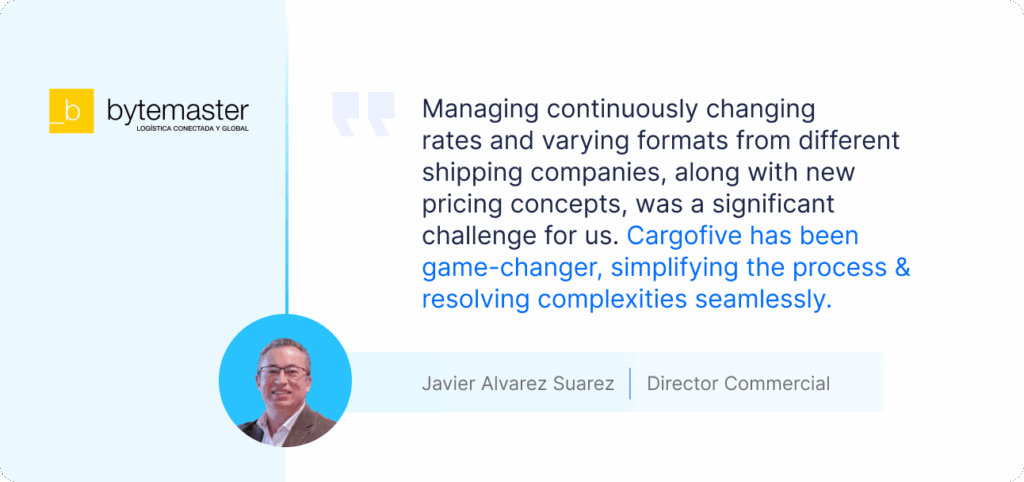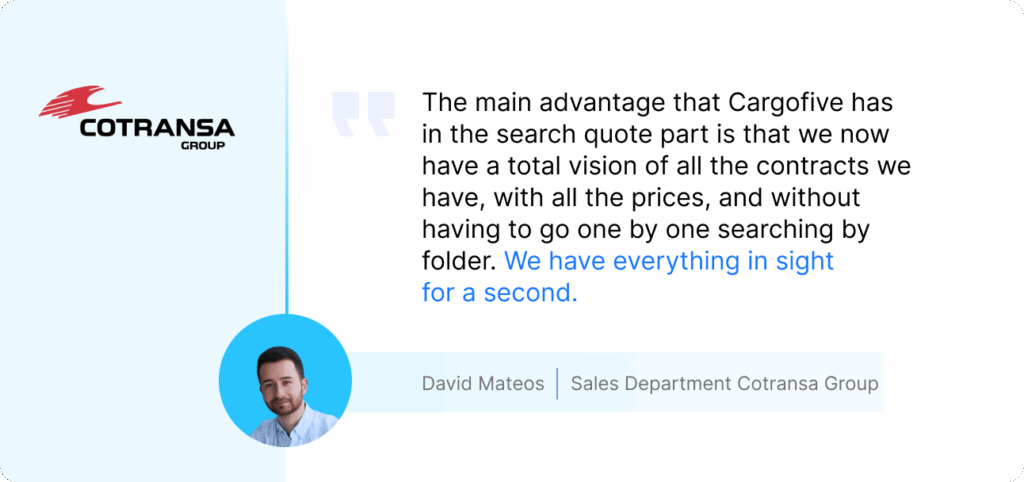
Freight quoting can be complex, with fluctuating costs, manual errors, and unpredictable surcharges. Customer-specific rates (CSP) simplify this by offering tailored pricing for individual shippers based on unique shipping patterns, volumes, and service needs.
Unlike market rates, CSP provides fixed rates, ensuring consistency and reducing financial uncertainty. Here’s why CSP matters
- Fewer Errors: Automation reduces manual data entry mistakes, cutting invoice errors by up to 15%.
- Cost Stability: CSP shields shippers from market volatility, avoiding dramatic price swings.
- Faster Quotes: Pre-loaded digital systems enable quotes in minutes, meeting 90% of shippers’ expectations for quick responses.
- Operational Efficiency: Integrated platforms streamline processes, reducing administrative workload and improving accuracy.
CSP is ideal for businesses spending over $200,000 annually on freight or shipping 100+ loads monthly.
By leveraging automation, maintaining accurate data, and negotiating strategically, companies can save costs, improve financial planning, and enhance customer satisfaction.
What Are Customer-Specific Rates
Definition of Customer-Specific Rates
Customer-specific rates are specially negotiated pricing agreements designed for individual shippers on particular shipping routes or lanes. In the less-than-truckload (LTL) sector, these rates go beyond standard market pricing.
Essentially, customer-specific pricing (CSP) provides a guaranteed rate tailored exclusively for one shipper, covering a specific lane, group of lanes, or origin point.
These rates are based on your company’s unique shipping patterns, volume commitments, and service needs. Typically, they are valid for 12 months and are not affected by carrier General Rate Increases (GRI) during that period.
CSP is particularly beneficial for businesses with significant LTL shipping volumes – generally those spending over $200,000 annually or shipping more than 100 loads each month.
By accurately predicting shipping patterns, carriers can offer more competitive pricing, creating a level of stability that sets CSP apart from other pricing models.
Customer-Specific Rates vs. Market Rates

The main difference between customer-specific rates and standard market pricing lies in their predictability and customization. Market rates tend to fluctuate based on supply and demand, whereas CSP provides consistency through negotiated agreements.
For instance, freight rates for a 40-foot container spiked from $1,342 in October 2023 to $4,200 by May 2024. Customer-specific rates protect shippers from such dramatic price swings by locking in pricing for designated lanes and service requirements.
Additionally, while truckload spot rates are heavily influenced by market dynamics, LTL pricing is shaped more by carriers’ operational efficiencies and internal pricing systems.
CSP allows carriers to optimize their networks based on how your shipments fit into their logistics, leading to more efficient and cost-effective solutions.
How to Set Up Customer-Specific Rates
Setting up customer-specific rates starts with analyzing your shipping patterns and negotiating strategically. Begin by identifying your primary shipping lanes, shipment sizes, and any special handling requirements.
A thorough volume analysis is essential, as carriers need predictable shipping volumes on specific lanes to justify offering customized rates. Negotiations should focus on your commitment levels, service expectations, and flexibility with pickup and delivery schedules.
Consider this example: A janitorial and sanitary supplier, ursource, managed to cut their shipping costs by $200,000 annually by partnering with a regional carrier to complement their national shipping strategy.
This illustrates how tailoring carrier partnerships and pricing agreements to your needs can lead to significant savings.
The goal is to strike a balance between commitment and adaptability. This ensures you lock in stable pricing while keeping the flexibility to adjust as your logistics needs evolve, ultimately improving quoting accuracy and cost efficiency.
How Customer-Specific Rates Make Quotes More Accurate
Customer-specific rates take the guesswork out of freight quoting, making the process more precise and predictable.
By tailoring negotiated terms to match your shipping patterns, quotes become far more dependable, cutting down on the variables that often lead to unexpected costs. Let’s explore how these rates improve accuracy through fewer errors, better financial planning, and automation.
Fewer Manual Errors in Freight Quotes

Manual calculations are ripe for mistakes, and in freight quoting, those mistakes can be costly. Using spreadsheets or manual data entry often results in mismatched rates, incorrect surcharges, and basic calculation errors – leading to an invoice error rate of up to 15%.
Digital systems simplify this by acting as a single source of truth, automatically applying pre-negotiated rates and significantly reducing errors.
For instance, Cargofive integrates with over 25 shipping lines and centralizes contract management, eliminating the need to juggle multiple rate sources.
This not only minimizes confusion but also cuts manual work by 80%, freeing your team to focus on customer relationships and more complex logistics challenges.
Better Budgeting and Financial Planning
When quotes reflect actual shipping costs, financial forecasting becomes much more reliable. Customer-specific rates ensure that budgets can be planned with confidence, incorporating negotiated terms like fuel surcharge waivers or guaranteed delivery windows.
For example, a company shipping full truckloads regularly might negotiate a 10% reduction in base rates while securing flexible contract terms to handle seasonal demand spikes.
In one case, a business shipping $7 million annually saved $2.4 million by leveraging analytics-driven contract negotiations.
By embedding these negotiated benefits directly into the quoting system, companies can generate more accurate and competitive estimates.
Using Automation for Correct Rate Application
Automation takes accuracy a step further by ensuring consistent application of customer-specific rates.
Unlike manual processes, which can be slow and prone to errors, automation offers both speed and precision.
Today, 90% of shippers expect digital quotes within two hours, and responding quickly can make a big difference – there’s a 75% chance of winning a quote if it’s sent the same day it’s requested.
Platforms like Cargofive integrate seamlessly with ERP and TMS systems, providing real-time access to negotiated rates without requiring manual input.
These systems go beyond simple rate lookups, using intelligent contract processing engines to handle complexities like tiered volume discounts, seasonal adjustments, and lane-specific surcharges.
The result? Quotes that are accurate, generated in minutes instead of hours, and consistently reflect your negotiated advantages.
This approach transforms rate management into a proactive, reliable system, ensuring every customer interaction benefits from your tailored terms.
Making Operations More Efficient with Customer-Specific Rates
Customer-specific rates are more than just a way to enhance accuracy – they simplify and optimize daily freight operations. By embedding negotiated terms directly into digital systems, businesses can act faster, work smarter, and focus their resources on long-term growth.
Faster Quote Response Times
In freight forwarding, speed is everything. Customer-specific rates bring automation into the mix, turning what used to be a time-consuming process into something much quicker. When rates are pre-loaded into digital systems, quotes that once took hours can now be prepared in minutes.
The impact of this shift is undeniable. Elizabeth Piña, a Digital Transformation Executive, highlights the efficiency gains:
“The automation of rates allows us to process and compare multiple freight rates quickly and accurately, saving considerable time in quoting and selecting the best offer from a carrier!”
With real-time rate integration, businesses can respond to quote requests in minutes rather than hours. This speed can be the deciding factor in securing new business, especially in competitive markets.
And the benefits extend beyond quoting – this efficiency ripples across broader system integrations.
Real-Time Rate Access and System Integration
The key to maximizing these speed advantages lies in seamless system integration. When customer-specific rates are directly linked to ERP and TMS platforms, teams can instantly access pre-loaded negotiated terms without juggling multiple systems.
A great example of this is the partnership between **Logistaas and Cargofive** in June 2025.
This collaboration gave freight forwarders instant access to ocean freight rates. Through this integration, Logistaas users can import valid quotations into the Offers module, send offers to clients instantly, convert them into bookings with just a few clicks, and automate the quoting process for faster and more competitive pricing.
As Kareem Naouri, CEO of Logistaas, explains:
“Freight forwarders need faster, more automated tools to stay competitive in today’s complex market and by integrating with Cargofive, we’ve eliminated the need for manual rate requests, spreadsheet comparisons, and lengthy emails.”
This kind of integration offers complete visibility into shipment costs, enabling real-time rate comparisons and improving negotiation strategies. Teams can make informed decisions quickly, leveraging current market data without delays.
Less Administrative Work
One of the most practical advantages of customer-specific rates is the reduction in administrative tasks. Traditional rate management often involves a maze of emails, phone calls, spreadsheet updates, and manual data entry – tasks that eat up time and pull employees away from more impactful work.
Digital platforms change this entirely. By centralizing rate management and automating repetitive processes, companies can dramatically cut down on manual work.
This isn’t just about saving time; it’s about redirecting staff to more meaningful tasks like building customer relationships and strategic planning.
Over time, the savings add up. Teams no longer need to maintain multiple rate sheets, chase carriers for updated pricing, or manually adjust contract details.
Instead, they can focus on analyzing shipping trends, finding optimization opportunities, and strengthening partnerships with key clients.
ERP integration ensures smooth coordination between freight rate management and other business operations.
This unified workflow reduces handoffs, eliminates data silos, and allows the entire organization to operate more efficiently – from the initial quote to the final invoice.
Benefits and Challenges of Customer-Specific Rates
After improving quoting accuracy and operational efficiency, it’s important to explore the benefits and challenges that come with customer-specific rates.
This pricing approach offers clear advantages but also presents some hurdles. Understanding these trade-offs is key to deciding if and when this strategy fits your business.
Pros and Cons Comparison
Implementing customer-specific rates means balancing operational perks with potential complexities. Here’s a side-by-side look at what businesses can expect:
| Benefits | Challenges |
|---|---|
| Cost certainty – Agreements typically last 12 months and are unaffected by carrier General Rate Increases (GRI) | Market volatility – Requires ongoing monitoring and quick adjustments to rate changes |
| Reduced volatility – Stabilizes costs for non-standard freight and eases pressure on internal logistics teams | Technology integration issues – Demands seamless integration with Transportation Management Systems (TMS) and compatible platforms |
| Volume leverage – Larger shipment volumes can secure better deals for Less-Than-Truckload (LTL) needs | Administrative workload – Includes regular contract updates, maintaining data accuracy, and staff training |
| Carrier familiarity – Dedicated carriers understand your business needs, improving service levels and reducing errors | Data management demands – Requires frequent updates to shipping details like weights, dimensions, and freight class |
| Time and cost savings – Eliminates the need for price comparisons across multiple carriers while offering tailored pricing | Ongoing communication – Requires consistent dialogue to handle unexpected changes |
| Service customization – Enables negotiation for specific needs such as Freight Of All Kinds (FAK) or commonly used accessorial services | Competitive pressure – Necessitates maintaining a competitive edge through personalized service and niche expertise |
This table highlights the balance between the benefits and challenges of customer-specific rates, offering a clear picture of what businesses might encounter.
For businesses considering this approach, certain financial benchmarks can help determine readiness. A typical threshold includes an annual LTL freight spend exceeding $200,000 or handling over 100 shipments per month.
To make the most of customer-specific rates, focus on leveraging technology, conducting regular reviews of contracts, and ensuring precise data management.
Companies with sufficient shipment volume and the resources to manage these complexities often find this approach delivers better cost predictability and improved service quality.
Best Practices for Managing Customer-Specific Rates
To make the most of customer-specific rates, it’s crucial to follow structured practices that focus on regular reviews, automation, and maintaining accurate data. By doing so, freight forwarders can streamline their operations, stay competitive, and reduce unnecessary administrative work.
Regular Contract Updates and Rate Reviews
Freight rates are constantly in flux, which makes regular reviews crucial for staying competitive. If your rate data is outdated, you risk issuing quotes that could lead to losses, especially in volatile markets where costs can change rapidly.
To avoid this, establish a consistent schedule for reviewing and updating rates. This ensures your pricing remains both competitive and profitable.
Effective contract management plays a big role here too. Keep track of expiration dates, monitor General Rate Increases (GRIs), and stay updated on carrier announcements.
By centralizing this information, you can create a reliable repository for benchmarking and making smarter decisions down the road.
These reviews set the stage for integrating digital tools that make the entire process faster and more efficient.
Using Digital Solutions for Automation
Digital tools have revolutionized how freight forwarders manage customer-specific rates, cutting down on manual processes that are often slow and prone to mistakes.
The best systems connect directly to data sources using APIs, enabling automatic updates and refreshes of rate information. By using standardized rate templates, you can streamline comparisons and speed up the review process.
Take Cargofive, for example. This platform has helped freight forwarders save over 90% of the time they used to spend on manual tasks.
With more than 100,000 contracts processed and over 5 million rate searches completed, Cargofive demonstrates how automation can handle large-scale operations efficiently.

Cargofive simplifies the process by consolidating rate information from different formats – spreadsheets, PDFs, emails – into one easy-to-use interface. This eliminates the need for manual data handling, making rate management faster and more accurate.

Maintaining Data Accuracy and Training Staff
Even with automated systems in place, the quality of your data and the training of your team are non-negotiable. A digital platform can’t fix errors caused by bad data or untrained users.
That’s why it’s essential to establish strict protocols for data entry, conduct regular validation checks, and ensure your staff is well-trained.
Your data storage should also comply with privacy regulations like GDPR. Choose platforms that prioritize security and keep detailed logs of rate changes, user actions, and updates to maintain accountability.
These logs help you track changes and ensure transparency.
Staff training is equally important. Regular sessions should cover both the technical aspects of using digital tools and the strategic side of rate management. Teach your team how to interpret market trends, adjust margins, and prioritize urgent rate updates.

Clear communication protocols are also vital. Establish channels for sharing rate updates, handling exceptions, and notifying stakeholders about changes. Combine this with real-time tracking and data analytics to identify areas for improvement and optimization.

Conclusion: Why Customer-Specific Rates Matter for Freight Quotes
Customer-specific rates have become a cornerstone for modern freight quoting, offering freight forwarders a competitive edge in a demanding industry. By moving away from generic pricing models, these tailored agreements deliver precision, efficiency, and stronger customer relationships.
With improved accuracy, pricing errors are minimized, allowing businesses to maintain predictable budgets and steady profit margins.
This level of precision supports faster and more effective responses, enhancing operational workflows. Additionally, the seamless integration of tailored rates into existing systems helps streamline processes, saving time and reducing complexity.
From a business growth perspective, customer-specific rates are game-changers. They help cut costs associated with acquiring new clients while fostering long-term loyalty. Research shows that acquiring a new customer is five times more expensive than retaining an existing one.
Moreover, increasing customer retention rates by just 5% can lead to profit increases ranging from 25% to 95%. When customers consistently receive accurate and transparent quotes, their trust and satisfaction naturally grow.
“In any competitive industry, whether you sell directly to consumers or to other businesses, building and maintaining strong relationships with clients is crucial for long-term success, and the same is absolutely true for logistics service providers like freight forwarders and customs brokers.” – Danya Rielly, Industry
Digital tools have made these tailored rates both practical and scalable. Platforms like Cargofive turn manual rate management into an automated, centralized process, offering real-time access to rates and contracts.
Even smaller freight forwarders can now effectively implement customer-specific pricing, leveling the playing field in this competitive space.

FAQs
How can businesses find out if they qualify for customer-specific freight rates?
Businesses aiming to secure freight rates tailored to their needs often have to meet specific benchmarks. For instance, many carriers require companies to spend at least $20,000 per month on freight or handle 50 to 100 less-than-truckload (LTL) shipments monthly. However, these thresholds can differ depending on the carrier, so it’s essential to check their individual requirements.
If your business qualifies, you could gain access to pricing that matches your shipping volume and patterns, offering potential cost savings and more precise quoting for your operations.
What are the advantages of using customer-specific rates over standard market rates for freight quotes?
Using customer-specific rates can bring several advantages over standard market rates. For starters, they offer more predictable costs, reducing the uncertainty that comes with fluctuating rates. This makes it easier to budget and plan effectively. Plus, these rates are customized to match your specific shipping requirements, leading to a more precise and efficient quoting process.
They’re especially helpful for non-standard freight or shipments that occur regularly. With these tailored rates, you gain consistency and stability over time. This means smoother operations and improved cost management for shippers looking to optimize their logistics.
How can companies successfully implement and manage customer-specific shipping rates?
To set up and manage shipping rates that cater to specific customer needs, businesses should begin with a detailed cost analysis. This helps outline shipping requirements and align them with the available budget. Creating a customizable rate structure based on customer demands is crucial for staying responsive in a fast-changing market.
Partnering with reliable carriers is another essential step, as it provides access to competitive pricing and dependable service. Using a digital freight management platform that offers real-time rate tracking and automation can make the entire process much smoother. Additionally, keeping an eye on market trends and adjusting rates when necessary ensures both accuracy and cost-effectiveness over time.
AUTHOR
